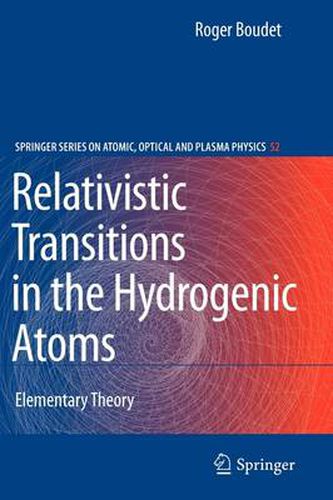Readings Newsletter
Become a Readings Member to make your shopping experience even easier.
Sign in or sign up for free!
You’re not far away from qualifying for FREE standard shipping within Australia
You’ve qualified for FREE standard shipping within Australia
The cart is loading…






This title is printed to order. This book may have been self-published. If so, we cannot guarantee the quality of the content. In the main most books will have gone through the editing process however some may not. We therefore suggest that you be aware of this before ordering this book. If in doubt check either the author or publisher’s details as we are unable to accept any returns unless they are faulty. Please contact us if you have any questions.
The aim of this volume is twofold. First, it is an attempt to simplify and clarify the relativistic theory of the hydrogen-like atoms. For this purpose we have used the mathematical formalism, introduced in the Dirac theory of the electron by David Hestenes, based on the use of the real Cli?ord algebra Cl(M) associated with the Minkwoski space-time M, that is, the euclidean 4 R space of signature (1,3). This algebra may be considered as the extension to this space of the theory of the Hamilton quaternions (which occupies an importantplaceintheresolutionoftheDiracequationforthecentralpotential problem). The clarity comes from the real form given by D. Hestenes to the electron wavefunctionthatreplaces,inastrictequivalence,theDiracspinor.Thisform is directly inscribed in the frame of the geometry of the Minkwoski space in which the experiments are necessarily placed. The simplicity derives from the uni?cation of the language used to describe the mathematical objects of the theory and the data of the experiments. The mathematics concerning the de?nition and the use of the algebra Cl(M) are not very complicated. Anyone who knows what a vector space is will be able to understand the geometrical implications of this algebra. The lecture will be perhaps more di?cult for the readers already acquainted with the complex formalism of the matrices and spinors, to the extent that the new language will appear di?erent from the one that they have used. But the correspondence between the two formalisms is ensured in the text at each stage of the theory.
$9.00 standard shipping within Australia
FREE standard shipping within Australia for orders over $100.00
Express & International shipping calculated at checkout
This title is printed to order. This book may have been self-published. If so, we cannot guarantee the quality of the content. In the main most books will have gone through the editing process however some may not. We therefore suggest that you be aware of this before ordering this book. If in doubt check either the author or publisher’s details as we are unable to accept any returns unless they are faulty. Please contact us if you have any questions.
The aim of this volume is twofold. First, it is an attempt to simplify and clarify the relativistic theory of the hydrogen-like atoms. For this purpose we have used the mathematical formalism, introduced in the Dirac theory of the electron by David Hestenes, based on the use of the real Cli?ord algebra Cl(M) associated with the Minkwoski space-time M, that is, the euclidean 4 R space of signature (1,3). This algebra may be considered as the extension to this space of the theory of the Hamilton quaternions (which occupies an importantplaceintheresolutionoftheDiracequationforthecentralpotential problem). The clarity comes from the real form given by D. Hestenes to the electron wavefunctionthatreplaces,inastrictequivalence,theDiracspinor.Thisform is directly inscribed in the frame of the geometry of the Minkwoski space in which the experiments are necessarily placed. The simplicity derives from the uni?cation of the language used to describe the mathematical objects of the theory and the data of the experiments. The mathematics concerning the de?nition and the use of the algebra Cl(M) are not very complicated. Anyone who knows what a vector space is will be able to understand the geometrical implications of this algebra. The lecture will be perhaps more di?cult for the readers already acquainted with the complex formalism of the matrices and spinors, to the extent that the new language will appear di?erent from the one that they have used. But the correspondence between the two formalisms is ensured in the text at each stage of the theory.